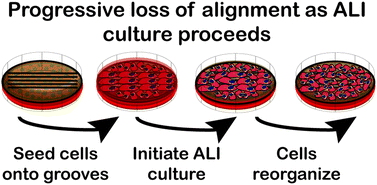Topographically grooved gel inserts for aligning epithelial cells during air–liquid-interface culture†‡
Abstract
Epithelial tissues are a critical component of all tubular organs. Engineering artificial epithelium requires an understanding of the polarization of epithelia: both apicobasal and in a planar fashion. Air liquid interface (ALI) culture is typically used to generate apicobasal polarized airway epithelium in vitro; however, this approach does not provide any signalling cues to induce morphological planar polarization of the generated epithelial layer. Here we describe a microgrooved gelatin hydrogel insert that can induce alignment of confluent epithelial cell sheets under ALI conditions to induce both apicobasal and morphologically planar polarized epithelium. Microgrooves are imprinted into the surface of the gelatin insert using elastomeric stamps moulded from a diffraction grating film and gels are stabilized by crosslinking with glutaraldehyde. We show that microgrooved gelatin inserts produce alignment of 3T3 fibroblasts and a number of epithelial cell lines (ARPE-19, BEAS2B and IMCD3 cells). Furthermore, we show that BEAS2B apicobasally polarize and form a similar density of cilia on both gelatin inserts and standard transwell filters used for ALI culture but that as apicobasal polarization progresses cell alignment on the grooves is lost. Our method provides a simple strategy that can easily be adopted by labs without microfabrication expertise for manipulating epithelial organization in transwell culture and studying the interplay of various polarization forces.

- This article is part of the themed collection: In celebration of Michael Sefton’s 65th birthday

 Please wait while we load your content...
Please wait while we load your content...